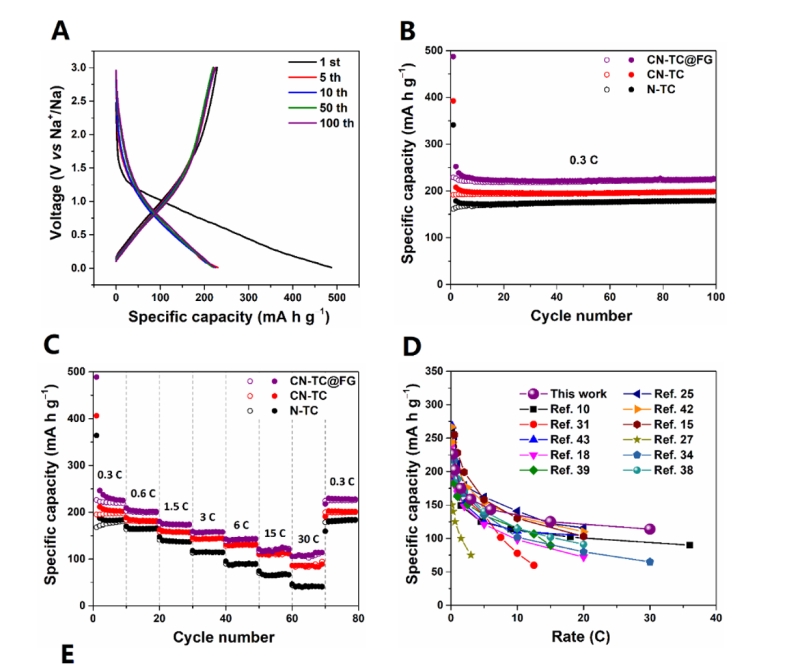Boosting sodium storage properties of titanium dioxide by a multiscale design based on MOF-derived strategy
成本低廉的钠离子电池是电网级储能设备的最有希望的候选者,然而缺乏高性能的负极材料制约了它的大规模应用。在可供选择的负极材料中,二氧化钛(TiO2)具有高的理论容量(335 mA g−1),适中的钠离子嵌入电位(~0.6 V vs Na+/Na),优异的结构稳定性以及赝电容特性,使其成为最具发展潜力的钠离子电池负极材料之一。然而,TiO2低的导电性和缓慢的钠离子扩散极大地限制了它的实际应用。
Cost-effective sodium-ion batteries (SIBs) are the most promising candidate for grid-scale energy storage. However, the lack of suitable high-performance anode materials has hindered their large-scale applications. Among the potential anode candidates, titanium dioxide (TiO2) shows high theoretical capacity (335 mA g−1), moderate insertion potential (~0.6 V vs Na+/Na), superior structural stability, and pseudocapacitive feature, which make it the most promising anode for SIBs. However, practical applications of TiO2 anode are severely limited by its poor intrinsic conductivity and sluggish Na+ diffusion.
目前,许多报道从不同的结构尺度上优化TiO2负极。例如,在原子尺度上,掺杂是提升TiO2内部电荷转移驱动力的有效手段;在微观结构尺度上,微/介孔结构和碳包覆有利于钠离子的扩散和电子的传导;在宏观结构尺度上,构筑大孔导电网络能够促进电解液的渗透和整个电极的导电性。然而,大部分的报道均是基于一到两个结构尺度设计的。因此,通过结合不同结构尺度设计的优势,进行一个多尺度设计(原子、微观结构和宏观结构尺度设计)预计能够进一步提升TiO2的储钠性能。然而,这种全方位的多尺度设计可能引入复杂的制备程序,从而导致成本增加和难以扩展等问题。
So far, great efforts have been devoted to optimizing TiO2-based anodes from different structural levels. For instance, at the atomic level, heteroatom doping is a feasible method for obtaining the internal charge-transfer driving force. At the microstructural level, microporous/mesoporous nanostructures and carbon coating are favorable for Na+ diffusion and electron conduction. At the macrostructural level, construction of 3D macroporous architecture with interconnected conductive network can significantly improve the Na+ diffusion capability and electron conduction of overall electrode.
最近,东南大学的陈坚教授和孙正明教授(共同通讯作者)从原子、微观结构和宏观结构尺度上设计了一种新颖的少层石墨烯包覆的钴、氮双掺杂的TiO2/C多级孔骨架结构(CN-TC@FG)。该设计使用钴掺杂、氨基化的钛基金属有机框架(CNH-T)作为多功能的前驱体,同时实现了钴、氮双掺杂(原子尺度),在介孔碳骨架中密封超细的TiO2纳米颗粒(微观结构尺度)以及赋予前驱体正的表面电荷,与带负电荷的氧化石墨烯(GO)自组装成大孔网络结构(宏观结构尺度)。而且,该设计是通过的金属有机框架衍生法一步实现的,极大地简化了制备程序。换句话说,这是一个“一石四鸟”的策略。当用于钠离子电池负极时,表现出优异的倍率性能和循环稳定性。该论文发表在能源类期刊Energy Storage Materials上,博士研究生徐晖为该论文第一作者。
Recently, Sun and Chen group in Southeast University reported a multiscale design for the synthesis of novelfew-layered graphene-wrapped Co, N double-doped mesoporous TiO2/C frameworks (denoted as CN-TC@FG) by a MOF-derived strategy. The Co-doped amine-functionalized Ti-MOFs (denoted as CNH-T) were used as multi-functional precursors to simultaneously achieve Co, N double-doping, and encapsulation of ultrafine TiO2 nanoparticles in mesoporousC frameworks, as well as to render the CNH-T a positively charged surface, which can be easily wrapped by negatively chargedgraphene oxide (GO) by electrostatic attraction and then self-assembled into a 3D macroporous network architecture. Moreover, our method is simplified and can be smoothly advanced to production scale. In other words, it is a ‘one stone, four birds’ strategy.As an anode for SIBs, the CN-TC@FG exhibits extraordinary rate capability and cycling stability.These findings have been published in the Energy Storage Materials.
全文链接:https://www.sciencedirect.com/science/article/pii/S2405829718306652
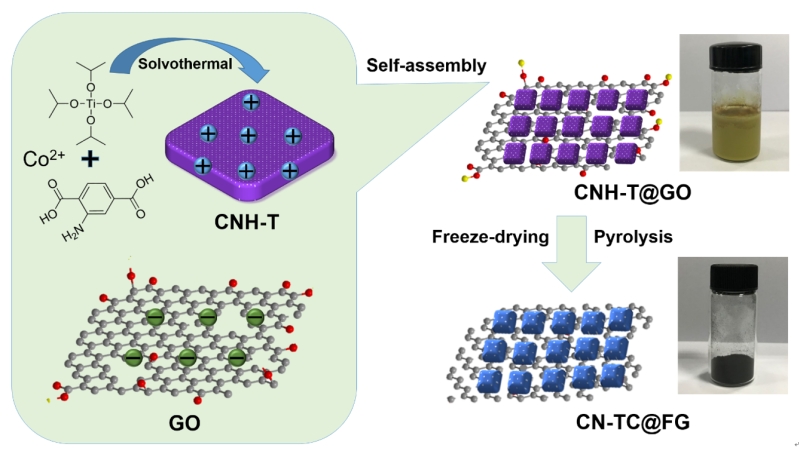
图 1.CN-TC@FG的合成示意图。
Figure 1. Schematic of the synthesis proceduresof the CN-TC@FG.
首先通过溶剂热法合成了CNH-T前驱体。CNH-T自带正的表面电荷,不仅可以通过静电吸引与带负电荷的GO紧密结合,还能为后续的自组装提供驱动力。因此,将CNH-T和GO混合后可以直接得到一个胶态溶液。此胶态溶液在50℃下静置数小时便自发地转变成CNH-T@GO水凝胶。然后通过冷冻干燥去除水凝胶中的水分,形成了大孔网络结构。最终,在氮气中热处理后获得产物CN-TC@FG。
The Co-doped amine-functionalized Ti-MOFs (CNH-T) were first synthesized by a facile solvothermal method. The as-synthesized CNH-T directly possesses positive surface charges withoutusing any additional surfactants, which not only enables it to closely combine withnegatively charged graphene oxide (GO) byelectrostatic attraction, but also will provide an internal driving force for the subsequent self-assembly. Therefore,a colloidal suspension was directly obtained after mixing the CNH-T and GO suspensions. The colloidal suspension spontaneously turned into a CNH-T@GO hydrogel at 50°C for several hours. The obtained CNH-T@GO hydrogel was then dehydratedby freeze-drying, in which the well-ordered interconnected macropores were formed.Finally, after pyrolysis in N2 atmosphere,the CN-TC@FG was obtained.
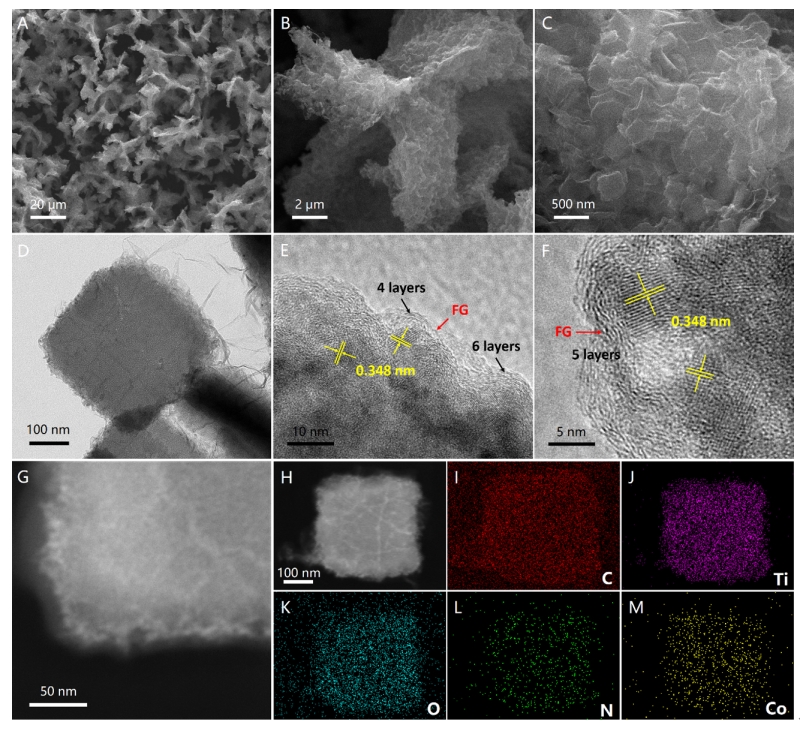
图 2.CN-TC@FG的形貌和微结构:(A-C)SEM图片,(D)TEM图片,(E和F)高分辨TEM图片,(G)高角度环形暗场STEM图片,(H-M)高角度环形暗场STEM图片和相应的EDX元素分布图片。
Figure 2. Morphology and microstructure of the CN-TC@FG. (A-C) FESEM images, (D) TEM image, (E, F) HRTEM images, (G) HAADF-STEM image, (H-M) HAADF-STEM image and the corresponding EDX elemental mapping images.
在宏观结构尺度上(图2. A-C),CN-TC@FG展示出一种连续的大孔网络结构,该结构有利于电子的转移和电解液的渗透;在微观结构尺度上(图2. D-G),超细的TiO2纳米颗粒均匀地嵌入到介孔碳骨架中,既促进了钠离子的扩散,又增强了TiO2颗粒周围的电子传导;在原子尺度上(图2. H-M),钴、氮双掺杂极大地提升了TiO2固有的导电性。
At the macrostructural level, the interconnected graphene macroporous network serves not only as an electrical highway in order that all active materials are electrochemically active, but also as ion reservoirs and thoroughfares to accelerate electrolyte percolation. At the microstructural level, the mesoporous TiO2/C frameworks provide effective diffusion channels for Na+, making themrapidly accessible to targeted TiO2 nanoparticles, as well as to ensure a high-efficiency electron transfer around the TiO2 nanoparticles. At the atomic level, the Co, N double-doping can significantly enhance the intrinsic conductivity of TiO2 and C due to the change in the electron-donor feature.
得益于多尺度的优化以及不同结构尺度的协同和耦合作用,CN-TC@FG电极展示出超高的比容量,超长的循环寿命和超快的赝电容钠离子储存能力。在6 C的电流密度下(1 C=335 mA g−1),5000次循环后可逆容量为174 mA h g−1;在15 C的电流密度下,10000次循环后可逆容量为121 mA h g−1;在30 C的电流密度下,3000次循环后可逆容量为100 mA h g−1。
Benefiting from the unique multiscale integration with the synergistic coupling effect between the structural levels, the CN-TC@FG manifests ultrahigh specific capacities, ultralong cycle life, and ultrafast pseudocapacitive sodium storage capability.In detail, the CN-TC@FG delivered high reversible capacities of 174 mA h g−1 at 6 C for over 5000 cycles, 121 mA h g−1 at 15 C for over 10000 cycles, and 100 mA h g−1 at 30 C for over 3000 cycles, demonstrating the most efficient TiO2-based anode ever reported for SIBs.
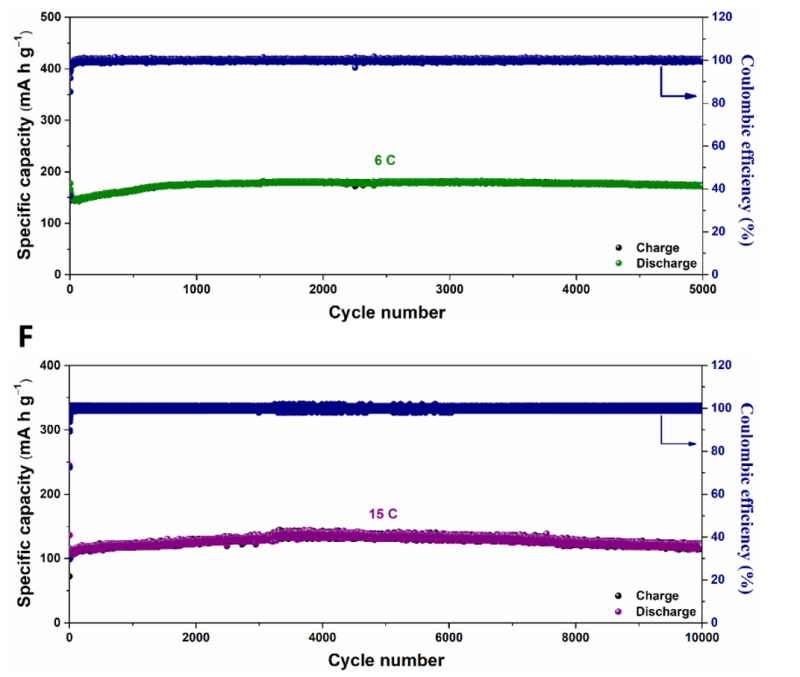
图 3.CN-TC@FG电极的电化学性能:(A)恒电流充放电曲线,(B)电流密度0.3 C下的循环性能,(C)倍率性能,(D)与近期报道的TiO2基钠离子电池负极材料的倍率性能比较,(E和F)电流密度6 C和15 C下的长程循环性能。
Figure 3. Electrochemical performance of the CN-TC@FG electrode. (A) Galvanostatic charge/discharge profiles at a current density of 0.3 C, (B) Cycle performance at 0.3 C, (C) Rate capability from 0.3 to 30 C, (D) Comparison of the rate capability of the CN-TC@FG electrode with the state of the art results in previously reported TiO2-based systems, (E and F) Long-termcycle performance at 6 and 15 C and corresponding Coulombic efficiency of the CN-TC@FG electrode.
此外,CN-TC@FG电极展示出明显的赝电容储钠特性。在不同CV扫速下的电容贡献率可以被量化。如图4. D所示,当扫描速率从0.2 mV s−1增加到5 mV s−1时,电容贡献率从58%增加到86.8%。高电容贡献允许快速地摄取和释放钠离子,同时减轻对电极结构的破坏,因此实现了杰出的倍率性能和循环稳定性。
In addition, the CN-TC@FG electrode shows an obviously pseudocapacitive sodium storage behavior. The contribution ratios of the capacitive charge at the different sweep rates can bequantified (Figure 4D). Obviously, the capacitive contribution gradually increases from 58.0% at 0.2 mV s−1 to 86.8% at 5 mV s−1. The high ratio of the capacitive contribution allows fast uptake and release of Na+ with little degradation of the electrode structure, which is responsible for the excellent rate capability and long-term cycling stability of the CN-TC@FG electrode.
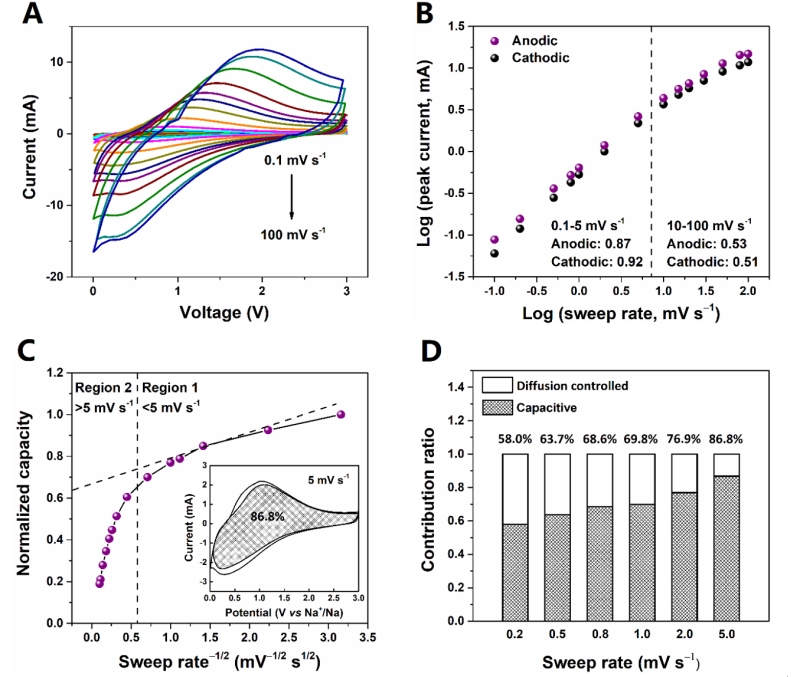
图 4.(A)CN-TC@FG电极CV曲线,(B)CV曲线的b值分析,(C)归一化容量,(D)不同扫速下的电容贡献率。
Figure 4. (A) CV curves of CN-TC@FG electrode at different scan rates from 0.1 to 100 mV s−1, (B) b-value analysis using the relationship between the peak currents and the sweep rates, (C) Normalized capacity versus sweep rate−1/2. The inset is the separation of the capacitive (shaded region) and diffusion currents in the CN-TC@FG electrode at a sweep rate of 5 mV s−1, (D) Contribution ratio of the capacitive and diffusion-controlled charges at different sweep rates.
更多学术成果介绍:
